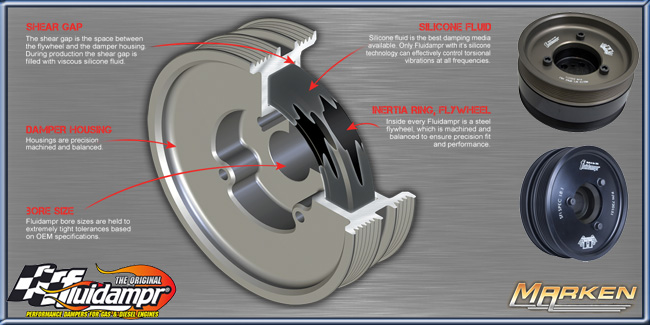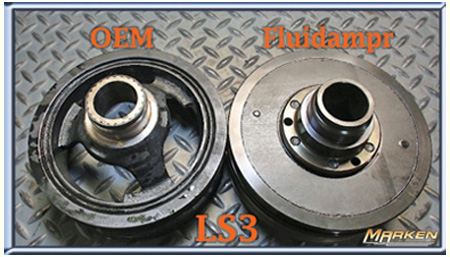Fluidampr’s new line of engine dampers are now available for:
1) 2013 Chevy LS3
2) Chrysler A/LA small block, B/RB big block and early Hemi applications.
3) Late Model Ford, GM, or Dodge/Ram Diesel Trucks
Call Marken Performance @ 1-888-401-1362 for your specific application, and have it shipped to USA or Canada.
These SFI 18.1 approved dampers will keep the power flowing to your wheels at all times without worrying about vibrations or imbalance in your engine. To meet the 18.1 spec, a damper has to endure spinning at between 12,500 and 13,500 RPM for an hour, among other things.


“The factory harmonic balancer is a tuned elastomer type. While adequate for mass produced daily drivers (like our 2013 Camaro 1LE, LS3 powerplant), tuned elastomer harmonic balancers only reduce the single worst destructive crankshaft torsional vibration peak within a narrow RPM range determined by the factory.”
With the promise of reduced wear to the main bearings, reduced wear to the timing gear, more accurate valvetrain operation and a lower risk of crankshaft failure, this non-underdrive component seemed to be the best option for the already performance-geared fifth-gen.
The point of a crankshaft damper is to reduce destructive crankshaft torsional vibration naturally generated while your engine is running. Stock dampers on cars these days are limited to around just a 50hz peak variance. If your car’s peak variance goes above that, you could be looking at unprotected engine components and damage to vital parts. By adding performance upgrades to your car, such as a camshaft swap, or even something as simple as an engine tune to allow higher revs, the chances of increasing your engine’s peak variance is high. That’s why on modified performance cars, it is recommended that you exchange the stock harmonic balancer for a more performance-capable unit.
How Does A Fluidampr Damper Work?
Unlike a stock elastomer harmonic balancer, Fluidampr performance dampers protect across a broad frequency range and can become more effective as magnitude increases throughout your RPM range. Each Fluidampr performance damper is designed for the engine application it is intended for.
Fluidampr performance dampers consist of a free rotating inertia ring inside a laser sealed outer housing within tight tolerance of each other. Both the inertia ring and the outer housing are computer balanced to exceed OEM specifications during manufacturing. Between the two, an area referred to as the shear gap is pressure injected with viscous silicone. This specialized silicone maintains stability across an extreme temperature range and provides superior heat dissipation.
As soon as your engine fires torsional vibration is present. To damp its destructive effects, the outer housing turns at engine RPM, while the inner inertia ring immediately self-centers and is free to be ‘shocked’ by each torsional vibration event. As the inner inertia ring moves in-and-out of RPM with the outer housing, the shearing force through the silicone transforms the vibration to heat, which rapidly dissipates through the housing. Since the mass of the inertia ring is engulfed in a thin film of silicone and not directly connected to the crank, it can be calculated that only 2/3 of the total Fluidampr weight is rotating at RPM. For example, a 7.9lb Fluidampr for a Chevy LS1 only feels 5.3lbs at rpm.
News
- Mar 26 2019 EBC New RP-1 Brake Pads for Racing
- Mar 11 2019 Bushwacker DRT Style™ Fender Flares
- Feb 23 2019 Flowmaster Cat-Back 717889 fits 2019 RAM 1500 Hemi
- Feb 11 2019 Optima Yellowtop Rectangle Battery # 9048-148, H6 Group 48
- Jan 18 2019 Holley New Larger EFI Pro Dash
- Jan 08 2019 Lucas Oil Low Viscosity Stabilizer #11097 + #11096 Intake Cleaner for Gasoline Direct Injection Engines
- May 05 2018 Thermo-Tech Rogue Series T3, T4 Turbo Cover
- Apr 30 2018 Holley’s Mid-Mount Kit # 20-200 for LT Swap, with accessories
- Apr 27 2018 SCT BDX Performance Programmer + Monitor + Adjustments
- Apr 23 2018 ReadyLift 7 inch Lift for 2014_UP Chevy 1500
Industry News
Loading


You must login to post comments.